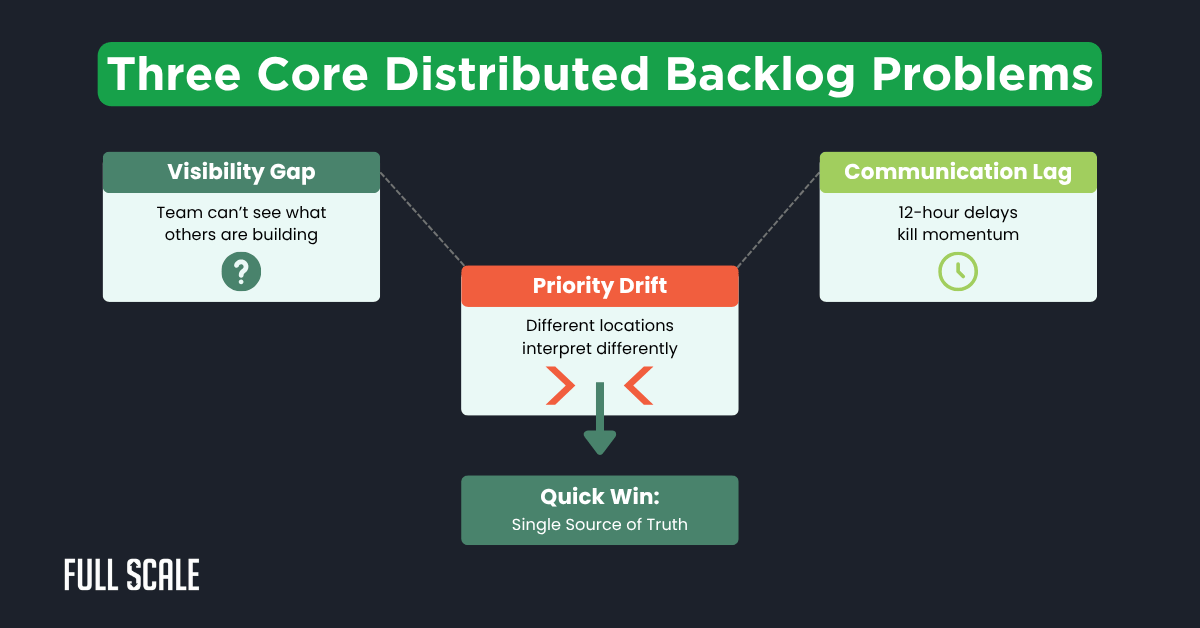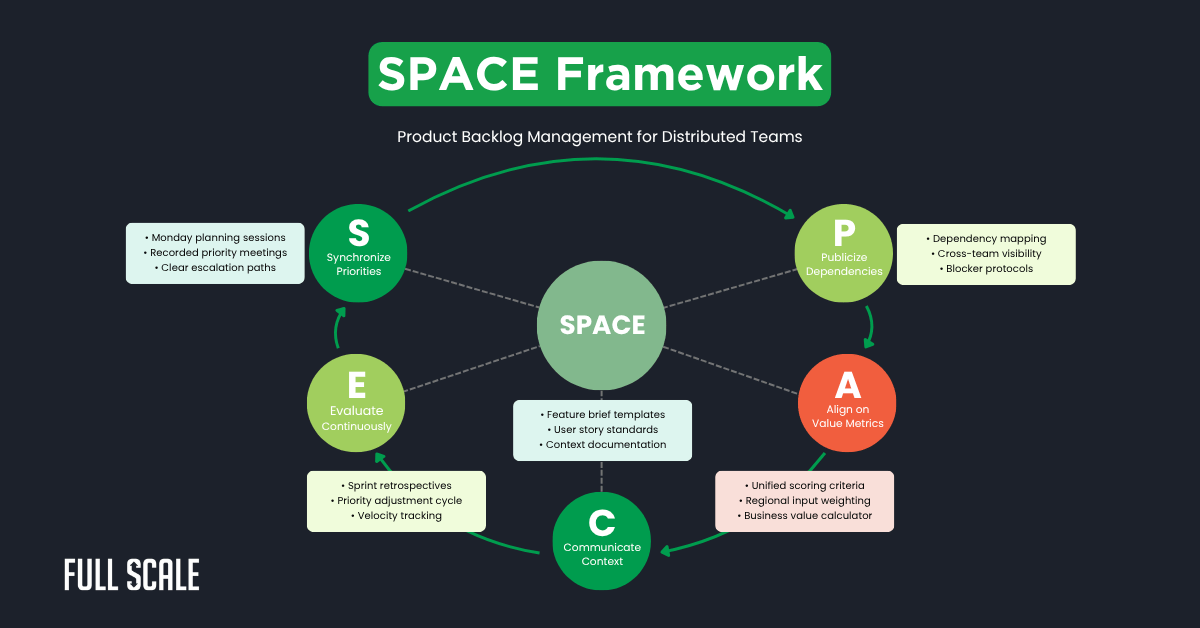Last Updated on 2025-09-19
When a growing SaaS company struggled with feature chaos across its US-Philippine teams, it shipped late 60% of the time. Six months later, it’s delivering 40% faster using the frameworks in this guide.
Product backlog management for distributed teams requires different strategies than co-located teams. According to Gitlab’s 2024 Remote Work Report, 67% of distributed teams cite poor prioritization as their biggest challenge.
This guide provides battle-tested solutions from real implementations.
The Distributed Backlog Challenge
Product backlog management for distributed teams organizes and prioritizes features across geographically dispersed developers. It ensures alignment, visibility, and consistent delivery despite time zones and cultural differences.
What Makes Distributed Backlogs Different
Traditional backlog management assumes everyone’s in the same room. Distributed teams face unique obstacles that break standard approaches.

This diagram shows why traditional backlog approaches fail distributed teams. Each problem compounds the others, creating feature delivery chaos.
The Real Cost of Poor Distributed Prioritization
McKinsey’s 2024 Developer Productivity Report found that distributed teams waste 31% more time on low-priority features. Stack Overflow’s 2024 Developer Survey reveals 74% of remote teams struggle with unclear requirements.
| Impact Area | Co-located Teams | Distributed Teams | Lost Productivity |
| Feature Rework | 15% | 38% | 23% increase |
| Priority Conflicts | 8% | 29% | 21% increase |
| Blocked Time | 12% | 43% | 31% increase |
| Meeting Overhead | 20% | 35% | 15% increase |
These numbers explain why remote product management frameworks matter. Without proper structure, distributed teams drown in confusion.
Now let’s explore the solution that transforms this chaos into clarity.
The SPACE Framework for Product Backlog Management for Distributed Teams
The SPACE framework transforms chaotic backlogs into streamlined delivery machines. We developed this after analyzing 50+ successful distributed team implementations.

Each SPACE element addresses specific distributed team challenges. Together, they create a complete prioritization system that scales globally.
Let’s break down each component to see how it works in practice.
Synchronize Priorities Weekly
Monday planning sessions unite teams across time zones. Record these sessions so Philippines-based developers can review before Tuesday starts.
Create three priority levels: Critical (this sprint), Important (next sprint), and Nice-to-have (backlog). Force rank within each level to prevent everything from becoming “priority one.”
This synchronization forms the foundation, but visibility remains crucial.
Publicize Dependencies
Hidden dependencies kill distributed team productivity. Use visual dependency boards showing which features block others.
Our clients using dependency mapping reduce blocked time by 67%. That’s because problems surface before they impact delivery schedules.
Yet visibility alone won’t align your teams on what matters most.
Align on Value Metrics
Different regions often have different ideas about feature value. Create unified scoring using:
Business Value + User Impact – Technical Effort = Priority Score.
Weight regional input based on customer proximity. US teams might score marketplace features higher, while the Philippine teams excel at technical debt priorities.
Even with aligned metrics, context can still get lost.
Communicate Context
Context evaporates across time zones without proper documentation. Every feature needs a one-page brief explaining why it matters.
Templates force consistency. When everyone documents the same way, offshore development prioritization becomes predictable.
But markets change, so your priorities must evolve too.
Evaluate Continuously
Static priorities fail in dynamic markets. Review and adjust every two weeks using velocity data.
Distributed agile prioritization requires more frequent calibration than co-located teams. Small adjustments prevent major course corrections later.
With the framework understood, let’s see how to prioritize features effectively.
Building Your Feature Prioritization Matrix for Distributed Teams
Visual prioritization beats endless spreadsheets for distributed teams. This matrix helps everyone understand priorities instantly.
Feature Prioritization Matrix Calculator
Feature Prioritization Matrix Calculator
(Do First)
(Plan Carefully)
(If Capacity)
Prioritized Features
This calculator adds time zone complexity to traditional priority matrices. Features requiring heavy cross-team coordination automatically score higher effort.
Distributed Team Adjustments
Standard matrices fail because they ignore distributed team realities. Add these three factors to your scoring:
Time Zone Complexity Score (1-5)
- 1 = Single region work
- 3 = Two regions coordinating
- 5 = Three+ regions required
Cross-team Dependencies (1-5)
- 1 = Independent feature
- 3 = Needs input from other teams
- 5 = Blocks multiple teams
Communication Overhead (1-5)
- 1 = Clear requirements exist
- 3 = Some clarification needed
- 5 = Heavy back-and-forth expected
These adjustments make the distributed team prioritization matrix templates actually useful. Generic templates miss critical complexity factors affecting product backlog management for distributed teams.
Now, let’s see these principles in action through a real transformation story.
Real Implementation: A SaaS Company’s Transformation
A fast-growing SaaS company struggled with its US-Philippine development team for months. Features shipped late, priorities constantly shifted, and developers felt disconnected.
The Breaking Point
Their San Francisco product team would prioritize features on Monday morning. By the time the Philippine developers started on Tuesday, requirements had already changed.
Sprint velocity dropped from 45 to 18 story points. Developer satisfaction scores hit 3.2/10.
Something had to change immediately.
Solution Implementation for Product Backlog Management for Distributed Teams
Week 1: We implemented basic SPACE framework elements. Created unified Jira boards with custom fields for distributed team factors.
Week 2: Introduced the prioritization matrix with time zone adjustments. Designate feature owners in each region to maintain context.
Week 3: Launched “Priority Thursdays” where both teams overlap for live sessions. Created feature brief templates requiring business context.
Week 4: Added dependency visualization boards showing cross-team impacts. Started tracking velocity by region.
Measurable Results
After 90 days, their metrics transformed completely:
| Metric | Before | After | Improvement |
| Sprint Velocity | 18 points | 52 points | 189% increase |
| On-time Delivery | 40% | 85% | 45% increase |
| Developer Satisfaction | 3.2/10 | 8.7/10 | 172% increase |
| Priority Changes/Sprint | 15 | 3 | 80% reduction |
The key wasn’t just better tools. It was creating systems that respect distributed team dynamics in product backlog management for distributed teams.
Success depends heavily on choosing the right tools for your teams.
Tools That Make Product Backlog Management for Distributed Teams Work
The right tools transform chaos into clarity. Here’s what works based on 60+ implementations with Philippines-based teams.
Essential Tool Stack
- Jira/Azure DevOps serves as your single source of truth. Configure custom fields for time zone complexity and cross-team dependencies.
- Loom/Vidyard enables async priority explanations. Record 5-minute walkthroughs rather than writing novels.
- Miro/FigJam visualizes priority relationships. Create living dependency maps showing how features connect.
- Slack/Teams handles real-time clarification. Create dedicated priority channels with threading for each feature.
Integration Best Practices
Automate status updates across time zones using webhooks. When the US teams update priorities, the Philippine teams get notifications before starting.
Product backlog management for distributed teams requires visual indicators for priority changes. Color-code features: green (stable), yellow (under discussion), red (changed).
Set up smart notifications for dependencies. When Feature A blocks Feature B, both owners get alerts.
Even with great tools, teams still face common implementation challenges.
4 Common Pitfalls in Product Backlog Management for Distributed Teams
Even great teams fall into these traps. Here’s how to avoid them when managing product backlog management for distributed teams.
1. The “Just Tell Them” Trap
Verbal priority updates evaporate across time zones. Your Philippine team won’t remember Monday’s brilliant explanation on Tuesday morning.
Solution: Document every priority decision with context. Use: Decision + Rationale + Impact format.
2. The “Everything is Priority 1” Problem
When everything’s critical, nothing is. Distributed teams can’t read body language for real priorities.
Solution: Force rank within priority levels. Only three items can be “Critical” per sprint.
3. The “Set and Forget” Mistake
Markets change faster than sprint cycles. Static priorities mean building features nobody wants anymore.
Solution: Schedule bi-weekly priority reviews. Spend 30 minutes validating current priorities against new data.
4. The “Local Hero” Issue
Regional product owners creating shadow backlogs destroys alignment. Each location starts optimizing for local needs.
Solution: Rotate feature ownership between regions. The US owns Feature A in this sprint, and the Philippines owns it in the next sprint.
Ready to implement these solutions? Here’s your roadmap.
Quick Start Checklist for Remote Team Feature Planning
Ready to transform your distributed team’s backlog? Follow this proven timeline for product backlog management for distributed teams.
Quick Start Checklist
Product Backlog Management Implementation Checklist
Week 1: Foundation
Week 2: Framework Setup
Week 3: First Implementation
Week 4: Optimization
This checklist turns theory into action. Most teams see improvements within two weeks of starting implementation.
Implementation success often depends on choosing the right partner.
Build Better Teams with Full Scale
Ready to transform your product backlog management for distributed teams?
Full Scale specializes in creating high-performing offshore development teams in the Philippines.
Why Partner with Full Scale
- Proven Track Record: Over 300+ successful client engagements since 2018
- Philippines Expertise: Deep understanding of US-Philippine team dynamics
- Integrated Teams: Developers who truly become part of your organization
- Direct Communication: No middlemen or project managers as barriers
- 95% Retention Rate: Happy developers mean consistent velocity
- Flexible Contracts: Month-to-month agreements, no lock-ins
- US-Based Protection: Contracts and IP protection under US law
Our staff augmentation model eliminates common challenges of product backlog management for distributed teams. Your Philippine developers join daily standups, use your tools, and follow your processes.
Build Better Teams Today
FAQs: Product Backlog Management for Distributed Teams
What makes distributed backlog management different from co-located teams?
Product backlog management for distributed teams faces visibility gaps, priority drift, and communication lag. The SPACE framework addresses these specific challenges.
How long does it take to see improvements using the SPACE framework?
Most teams implementing product backlog management for distributed teams see improvements within two weeks. Full transformation takes 60-90 days.
What tools are essential for distributed team prioritization?
Essential tools for product backlog management for distributed teams include Jira/Azure DevOps, Loom/Vidyard, Miro/FigJam, and Slack/Teams.
How do you handle priority conflicts between the US and the Philippine teams?
Product backlog management for distributed teams requires force ranking and rotating feature ownership between regions.
What’s the biggest mistake companies make with offshore backlogs?
The “just tell them” trap ruins product backlog management for distributed teams. Document everything with context.
How does Full Scale’s model differ from traditional outsourcing?
Full Scale’s staff augmentation creates true team extensions, eliminating most product backlog management for distributed teams challenges.
Can small startups benefit from these frameworks?
Small teams see faster improvements in product backlog management for distributed teams due to less organizational inertia.
How do you measure success in distributed backlog management?
Track velocity, on-time delivery, satisfaction scores, and priority changes for successful product backlog management for distributed teams.
What percentage of distributed teams fail at backlog management?
Atlassian’s 2025 State of Teams Report shows 82% of distributed teams struggle with backlog alignment initially. However, teams using structured frameworks see 70% improvement within three months.

Matt Watson is a serial tech entrepreneur who has started four companies and had a nine-figure exit. He was the founder and CTO of VinSolutions, the #1 CRM software used in today’s automotive industry. He has over twenty years of experience working as a tech CTO and building cutting-edge SaaS solutions.
As the CEO of Full Scale, he has helped over 100 tech companies build their software services and development teams. Full Scale specializes in helping tech companies grow by augmenting their in-house teams with software development talent from the Philippines.
Matt hosts Startup Hustle, a top podcast about entrepreneurship with over 6 million downloads. He has a wealth of knowledge about startups and business from his personal experience and from interviewing hundreds of other entrepreneurs.




